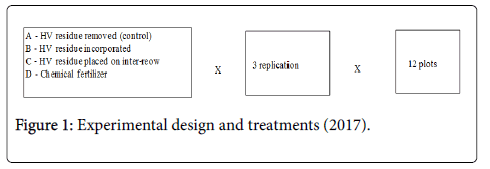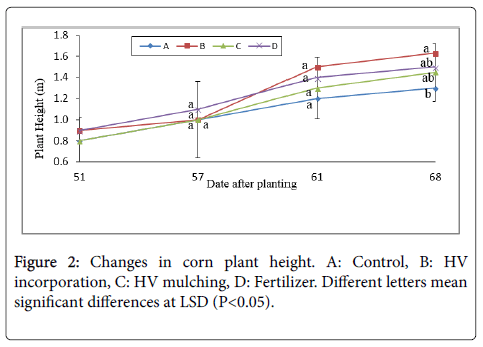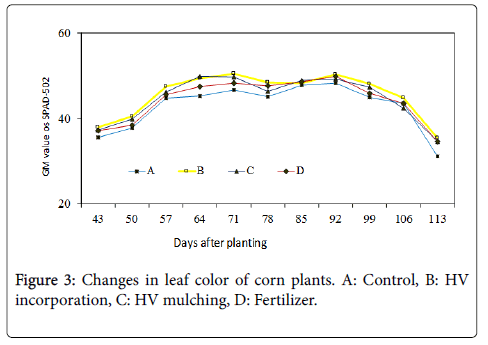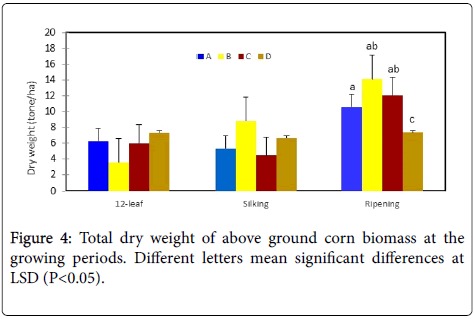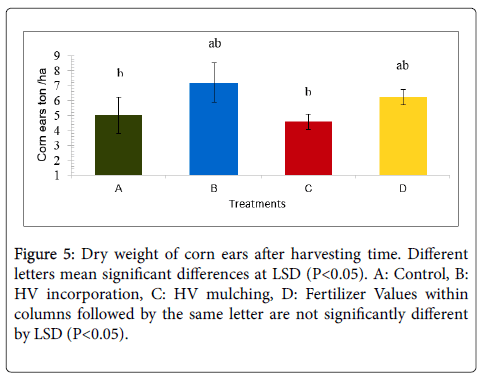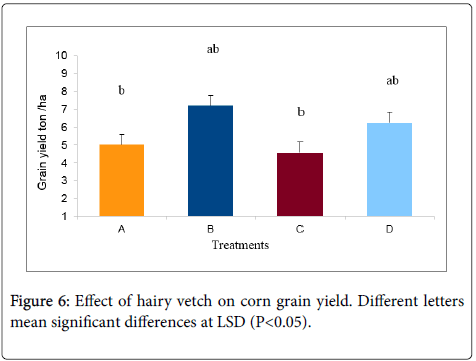Effects of Green Manure (Hairy Vetch) Management Ways on Corn Growth and Grain Yield
Received: 08-Jun-2018 / Accepted Date: 25-Jun-2018 / Published Date: 03-Jul-2018 DOI: 10.4172/2329-8863.1000380
Keywords: Green manure; Hairy vetch; Corn grain; Corn ears; Above ground biomass; Inorganic fertilizer
Introduction
The world’s population is expected to increase 50% over the next four to five decades, requiring a doubling of food output to accommodate this human expansion plus those moving up the food chain [1,2]. The average cereal production per unit area in the developing countries still low. Insufficiency of nutrients, especially nitrogen (N), is pointed out as a main cause for this low yield in these countries. Therefore, in these regains, where fertilizer cannot be sufficiently used because of economic reasons, it is necessary to exploit the other nutrient sources [3].
Recently, there are some examples of success in yield increase of main crops [4,5] and in improving the soil fertility by utilizing green manure and cover crops (GMCCs) in Latin America and Southeast Asia [6,7]. In many cases, legumes like hairy vetch (Vicia villosa Roth HV), mucuna (mucuna pruriens ), crotalaria (Crotalaria juncea L.) and sesbania (Sesbania roatrata ), has been cultivated as GMCCs to supply organic matter and N fixed by rhizobia to soil [8-10].
In fact, it is well known that GMCCs supply high amounts of organic matter to soil and improve soil structure via promotion of aggregation and increased water infiltration capacity [11] and root growth of the succeeding crops [12], and to control soil erosion [9,13]. Other roles include temporary caching of nutrients remaining in fields, prevention of nutrients from leaching and assurance of their supply to succeeding crops. From this perspective, winter GMCCs have been used increasingly to scavenge remaining N in soils after crop harvesting in summer or autumn, to return organic matter to the soil [14,15], to increase the N supply to succeeding summer crops [8,16].
Hairy vetch has been reported as the best cover crop and its careful management will be successful in subsequent crops. Therefore, HV is evaluated as an important GMCC for sustainable production systems [4,17]. HV residue is rapidly decomposed in soil because of its high N concentration and low C/N ratio, thereby increase corn yield similarly to fertilizer N rates of 66 to 200 kg ha-1 [18]. Therefore, a primary reason for the use of HV as GMCCs is its capacity to provide most of the N requirement of crops such as corn [19]. It is reported by Abdul- Baki and Teasdal [4] that a vetch cover crop produced 3,000 to 5,000 pounds of dry matter per acre between October and May that contains about 120 to 200 pounds of N per acre. This level of N production is sufficient to meet most of the requirement of corn [11,20]. Most research indicates that HV contributes an equivalent of 60 to 90-pound N per acre [9], and the resulted yields are usually economically competitive with the corn produced by receiving 125 to 250-pound fertilizer N per acre [10].
Managing GMCCs residues before planting the succeeding crop is one important part of the whole production system, which deserves more attention [21]. Crop residue management in agricultural soils has also received much attention as a key to sustainability in conservation cropping system [22]. Adapted tillage practices also determine the initial location and distribution of crop residues in soil that, in turn, act directly on soil physical properties [23]. One advantage of legumes in cropping systems is that their biomass residue tends to decompose quickly in soil and supply a substantial amount of N to soils, although their effectiveness on crop growth is poorer than that of mineral fertilizers [23]. Winter annual legumes can be used in two different ways; either by transplanting a main crop into a row growing species, or by growing a tall species before transplanting the main crops [3,12]. A careful GMCCs management program during the growth period might enable farmers to increase the dry matter yield of subsequent crops through the N supply [9]. Many researchers reported that mulching of HV provides 50-120 kg N ha-1 to soil but a few reports were published on the mulching effect [9].
HV is not a new crop in Afghanistan, but the wild varieties is growing many years ago in various areas in order to forage for animals but not as a green manure.
Among the many methods of GMCCs management, the recent focus has been on incorporation of organic matter into the soil, or its placement on the soil surface. These methods can affect the amount of N released from residue, and also have effects on weed suppression, prevention of runoff, and conservation of soil moisture [24].
Corn (Zea mays) is the third leading cereal crop in the world after wheat and rice. Corn is the main second important cereal crops in Afghanistan as well. The corn yield is decreased considerably by insufficiently nutrients like nitrogen. Corn average obtained in our country between 2014 and 2015 years was 0.136 million tons and the cultivation area was 0.127 million hectares [3]. The drought continued for corn has just been confined to the existed water areas. On the other hand, the lack of appropriate market compared with other grains is less interested in corn cultivation. Primarily corn is cultivated for seed production and secondly for forage and raw industrial materials. Grain maize is consumed for human and animal consumption [20]. Maize cultivation depends on tropical, subtropical and warm temperate zones that have sufficient quantity of rain or water. Central America was the origin of maize. Corn has been the main cereal crop for food supply in North, Central and South parts of America [25,26].
Corn cultivation area pretending as worldwide in 118.6 million hectares of land and the yield is estimated 1021.6 million tons. Oil obtained from corn seeds looked very good. The maize grain chemical composition quality basis on a dry weight is 77% of starches, 2% sugar, 9% protein, 5% fat and 2% ash. The corn seeds also have an amount of 10-12 percent protein, vitamins A, E, C, irreplaceable amino acids, mineral salts and trace elements [26].
The content of the economic value of corn raised to 25 percent of global strains of maize provided food. The people of some countries like Tanzania, Nigeria, Utopia, Mexico, Afghanistan and etc., they made bread from flour of corn which is used for eating. Nevertheless, the corn seed oil is extremely high in most baked form it is used [2].
As of grain corn (Ascorbic acid), starches and glucose, are also recoverable. Corn green fodder and silage is used to feed animals. One kilogram of dry grain corn has about 78 gr of digestible protein for animal feed, which is considered valuable [27]. Corn rich in nutrients required for body and are also rich in fiber. Corn oil is rich in linoleic acid, one of the two acids is essential for healthy skin. Corn oil is used for local skin allergies and lowers blood cholesterol. Corn silk is diuretic due to existing high potassium. The decoction of the leaves of corn is used for bladder stone [15,28].
The objectives of this excrement were to evaluate (i) the effect of residue management (incorporation or mulching) on the growth and yield of corn and (ii) utilization of HV in crop rotation system with maintenance environment. We hypothesized that the growth and grain yield of corn would be similar or greater with HV compare with that obtained using an inorganic fertilizer treatment.
Materials and Methods
The experiment was carried out from 2017-2018 in an upland field of (108 m2) at the Research Farm of Faculty of Agriculture Kabul University, Kabul Afghanistan. Soil of the experimental site was a volcanic ash soil, Slic Andisols .
Experimental design
Four treatments were established (Figure 1) A: Control, in which HV residue was removed; B: HV residue incorporated into soil; C: HV residue mulched on soil surface (residue placed on soil surface on inter-rows) and D: fertilizer urea 50 kg h-1 applied during at 8-leaf stage of corn. Three replications of these treatments (plot size 3 × 3 m) were established in the field.
Field operation
HV was planted in all plots in November 2017. After tiling the experimental field with a rotary tiller, HV seed was sown in rows with 60 cm spacing by hand. Than for the sake of growing HV, 3 times in each week irrigation was supply. After winter time, the irrigation supply was continue up to end of March 2018 for growing HV.
HV of B plot was moved with a rotary mover to break the plants into small pieces to prevent from dragging, which makes tillage and seeding work hard. HV of A, C and D plots were slashed by a hand sickle. According to the experimental design, the residues were completely removed from A and D plots. In C plot, the residue was removed temporarily, the plot tilled, and then the HV replaced back on the inter-rows (70 cm spacing). In D plot, fertilizer as urea was applied at a rate of 50 kg-h and the plot were cultivated with a tiller.
Two weeks later (June 5, 2017), corn seeds (Watani Kohistan Kapisa) were planted in all the plots at a depth of 2-3 cm. The inter-row spacing was 18-20 cm and the row width was 70 cm. The seeding density was 83,333 seeds ha-1. Weeds were adequately controlled by a hand-hoe and hand weeding twice before the 8-leaf stage. Irrigation was applied between 8-10 days based on the need.
Measurements of plant height, leaf color, above-ground biomass, corn ears and grain yield
Corn plant height (from soil surface to the plant growth apex) was measured with a ruler. Three plants were randomly chosen from each row of each plot and their heights were measured every week from mid-July to the end of silking stage. Three plants were chosen randomly from each row of every plot for measurement of leaf color. Leaf color of the fully opened top leaves was measured with a chlorophyll meter (Minolta SPAD-502) from mid-July until harvesting time.
Furthermore, the number of leaves was also counted during the measurement in order to examine the period of corn growth stage. For measuring the above-ground biomass (AGB) of corn, three plants from each row were randomly harvested from the ground level at the 12-leaf stage, silking, and ripening stage. The fresh weight of each plant was measured separately and one plant that represented the average weight was selected from the plants in each plot. This subsample was chapped and oven-dried at 70°C for 3 days the dry weights were measured.
Corn ears and grain yields from each plot were measured as follows; from 12 plants harvested randomly on October 15, 2017. Corn ears were separated from the plants and their husks removed, and then their fresh weights were measured. Then, all corn ears were oven-dried at 70°C for 3 days and the dry weight was measured. All grains were detached from the cobs by hand and the dry weight of seeds and cobs were measured.
Statistical analysis was carried out by standard ANOVA and multiple comparison procedure, Fisher’s Protected Least Significant Difference (PLSD).
Results and Discussion
Plant height
Corn plant height was not influenced by the incorporation of HV at 8-leaf stage (Figure 2). Most treatments showed the same growth in plant height, suggesting that the soil fertility of all plots was the same in field area. Plant height in D plots was increased from 51 DAP up to middle of next stage despite no significant difference. The smallest increase in plant height was in A plot from 51 DAP.
At 12 leaf stage, plant height was influenced by the incorporation of HV (Figure 2). Plant height in B plots was increased from 57 DAP up to end of corn growing period despite no significant deference. Plant height of D and C plots began to increase their height from 57 DAP up to 67 DAP but the smallest increase in A from 57 DAP. Up to this stage, still HV residues was not decomposed completely to affect corn plant height significantly but it seems up to the next stage HV residues will decompose and the effect will be appear well.
Plant height during at silky stage was completely influenced by HV incorporation (Figure 2). Plant height was increased in B plots from 61 DAP and continue to 68 DAP then A, C and D treatments. There are significant difference between A and B treatments but no significant differences observe between B, C and D treatments.
These results demonstrated that incorporation or mulching of HV residue promoted corn growth over a short-term (1 year) period.
Leaf color (LC)
The changes in leaf color of plants are shown in Figure 3. Leaf color is widely used as an indicator of chlorophyll content. Leaf color (LC) began to increase at 8-10 leaf-stages (45-52 DAP) and increased gradually until approx. 71 DAP, but leaf color was deepest in B plot (Figure 4), suggesting that N supply to corn was greatest after incorporation of HV residue, especially when water was supply very much during the summer. Horimoto et al. also reported that more than 50% of the N in HV residue was released during 4 weeks after HV incorporation [29].
Above ground biomass (AGB)
The AGB of corn was not affected significantly by the treatments at the 12-leaf stage, but there was no significant deference between treatments (Figure 4). The slight decrease of AGB in D plot, which received N fertilizer and followed by C, B and A treatments. This result is the same as plant height because of still no decomposition of HV residue.
The effects of the treatments on AGB were visible from the silking stage onwards; greater AGB was observed in B plots than in A, C and D, A plots (Figure 4). There was significant differences between B and D testaments but no significant difference between A, B and C treatments. It was considered that the incorporation of HV had a larger N supplying effect than that surface placement.
At the ripening stage, AGB was affected by the treatments in B plots (Figure 4). There was no significant differences between treatments however, AGB of B and C treatments was increased due to N supply from the residue became much clear. Seo et al. reported that immobilization of added N was consistently greater from HV residues than fertilizer, since the decomposition rate was attributed to the close association of C and N in residues compared with inorganic fertilizer N [12]. The method of residue management, incorporation or mulching, had no clear effect in this experiment. This contrast with the results of Sainju who reported that HV residue released N more rapidly when incorporated into soil than when left on the soil surface [30,31].
Corn ears
Based on dry weight of corn ears, B treatment increased the amount of ears then D, A and C treatments (Figure 5 and Table 1). There were significant differences between A, B and B, C treatments but no significant difference observed between C, A and D treatments. The mean reason for increases corn ears in B treatment is the N release from HV residues in soil.
| Treatments | Corn Ear Mg ha-1 | Corn Grain Mg ha-1 |
|---|---|---|
| A | 5.0b | 5.0b |
| B | 7.2ab | 7.2ab |
| C | 4.6b | 4.6b |
| D | 6.2ab | 6.2ab |
Table 1: Amount of corn ear and grain yield.
Grain yield
The maize grain yield seemed to be positive affected by the HV treatments in B plots with 7.2 Mg ha-1 while the yield from plot D was 5.5 Mg ha-1. The yield of A pot, 4.6 Mg ha-1, followed that of C plot with 4.6 Mg ha-1 (Figure 6 and Table 1). Although there was significant difference between B, A and B, C treatments. Sharifi conducted the same research in Japan and got similar results [9].
Based on analysis of variance, there were significant differences of yield among blokes at 5 percent level (Table 2). Both, corn grain and ears yields are similar, which indicate the precision of this research as well as low CV shows that research has been performed accurately.
| Sources of Variation | Degree of Freedom | Sum of Squares | Mean of Squares | F-Observed | F-Table | |
|---|---|---|---|---|---|---|
| 5% | 1% | |||||
| Total | 11 | 20.3 | ||||
| Block | 2 | 1208 | 6.4 | 15.4** | 5.14 | 10.92 |
| Treatment | 3 | 5.1 | 1.68 | 4.0 | 4.76 | 9.87 |
| Error | 6 | 2.5 | 0.42 | |||
Table 2: ANOVA for corn grain yield.
Conclusion and Recommendations
Both treatments of the incorporation HV and the surface placement of HV residue increased the corn AGB and grain yield. The grain yield increased significantly in B (HV-incorporated) plots, suggesting that N derived from HV residue was used by corn as effectively as N from fertilizer. It is concluded that incorporation or surface-placement of HV residue has a remarkable possibility of supplying the fixed N to succeeding corn plants. The succeeding crop (corn) was able to utilize this N, but an appropriate supply of minerals is also required to ensure successful growth of HV and sustain corn production over the long term.
It is recommended that HV must be cultivate between mid- September and mid-October and incorporated when it begins to flower (in this study also it performed in the mentioned stage). Due to its rapid spring growth, delaying the incorporation for just 1 or 2 weeks can increase dry matter and N accumulation considerably for the next crop sowing like corn. Hairy vetch is the best crop for rotation system by the reason of the synchrony of N release and N demand by corn and it is recommended for farmers to use at least between each three years in their husbandries. After three years with continues use of HV in the same field, fertilizer N is required in addition to HV, to maintain the maximum yield of corn. Use of HV as a green manure was preferable to supply N to succeeding corn plants and there is a possibility to reduce the application rate of N fertilizer in corn production.
Acknowledgements
We would like to extend our gratitude to all staff members of agronomy department of the faculty of Agriculture also World Bank for providing of fund of this research and likewise farm staff of agriculture faculty of Kabul University for their sincere cooperation.
References
- Ahmadi MS, Wakil-Ahmad S, Mohammad ZS, Zabehuuah J (2016) Weed Science. Azeem Publication, Kabul, pp: 174-175.
- Morris NL, Miller PCH, Orson JH, Froud-Williams RJ (2009) The effect of wheat straw residue on the emergence and early growth of sugar beet (Beta vulgaris) and oilseed rape (Brassica napus).European Journal of Agronomy30: 151-162.
- Sharifi MZ, Matsumura S, Hirasawa T, Komatsuzaki M (2009) Apparent nitrogen mineralization rates of several green manures incorporated in soil and the application effects on growth of komatsuna plants.FarmWorkResearch44: 163-172.
- Abdul-Baki AA, Teasdal JR (2007) Sustainable production of fresh market tomatoes and other vegetables with cover crop mulches. USDA-ARS Farmers, p: 31.
- Baijukya FP, De Ridder N, Giller KE (2006) Nitrogen release from decomposing residues of leguminous cover crops and their effect on maize yield on depleted soils of Bukoba District, Tanzania.Plant and Soil279: 77-93.
- Gunn CR (1971) Seeds of native and naturalized vetches of North America.US Dep Agric: Agric Handb, pp: 1-3.
- Henson PR, Schoth HA (2011) The trefoils adaptation and culture. USDA Handbook, p: 223.
- Sharifi MZ (2010) Increase of corn grain yield and improvement of nitrogen balance by introducing green manure crops. Doctoral Thesis, Tokyo University of Agriculture and Technology, Tokyo, Japan pp: 56-61.
- Sharifi MZ, Shoji M, Masahiro T, Tadashi H, Masakazu K (2011) Improvement of nitrogen balance by rotating corn and hairy vetch. J Farm Work Research 46: 166-177.
- Hermann FJ (2011) Vetches in the United States native naturalized and cultivated. USAD Handbook, p: 168.
- Seo JH, Meisinger JJ, Lee HJ (2006) Recovery of nitrogen-15–labeled hairy vetch and fertilizer applied to corn.Agronomy Journal98: 245-254.
- Quemada M (2004) Predicting crop residue decomposition using moisture adjusted time scales.Nutrient Cycling in Agroecosystems70: 283-291.
- Sharifi MZ (2014) Biological weed control and its relation to herbicides and environment. Kabul University, Academic Conferences on Assurance Quality, pp: 138-152.
- Teasdale JR, Abdul-Baki AA, Park YB (2008) Sweet corn production and efficiency of nitrogen use in high cover crop residue.Agronomy for Sustainable Development28: 559-565.
- Coppens F, Garnier P, Findeling A, Merckx R, Recous S (2007) Decomposition of mulched versus incorporated crop residues: modelling with PASTIS clarifies interactions between residue quality and location.Soil Biology and Biochemistry39: 2339-2350.
- Verhallen A, Hayes A, Taylor T (2008) Cover crops: Hairy vetch. Ministry of Agriculture Food and Rural Affairs, Ontario.
- Bennetzen JL, Hake SC (Eds.) (2008)Handbook of maize: its biology. Springer Science & Business Media.
- Keene CL, Curran WS, Wallace JM, Ryan MR, Mirsky SB, et al. (2017) Cover crop termination timing is critical in organic rotational no-till systems.Agronomy Journal109: 272-282.
- Yosofi MQ (2010) Corn cultivation in Afghanistan. Strength Project and Agriculture Develop Section in Afghanistan, P: 10.
- Miller FP (2008) After 10,000 years of agriculture, whither agronomy?.Agronomy Journal100: 22-34.
- Lowry CJ, Brainard DC (2017) Rye-vetch spatial arrangement and tillage: impacts on soil nitrogen and sweet corn roots.Agronomy Journal109: 1013-1023.
- Murrell EG, Schipanski ME, Finney DM, Hunter MC, Burgess M, et al. (2017) Achieving diverse cover crop mixtures: effects of planting date and seeding rate.Agronomy Journal109: 259-271.
- Sanchez GC, Gatan MG (2007) How to grow corn?. Open Academy for Philippine Agriculture.
- Sharifi MZ, Zabehullah J, Atefa S (2017) Effect of Different Ways of Weeds Control on Corn Grain Yield. International Journal of Science and Research 7: 2253-2257.
- Yeganehpoor F, Salmasi SZ, Abedi G, Samadiyan F, Beyginiya V (2015) Effects of cover crops and weed management on corn yield.Journal of the Saudi Society of Agricultural Sciences14: 178-181.
- Horimoto S, Araki H, Ishimoto M, Ito M, Fujii Y (2002) Growth and yield of tomatoes in hairy vetch-incorporated and-mulched field.Japanese Journal of Farm Work Research37: 231-240.
- Sainju UM, Singh BP, Whitehead WF, Wang S (2007) Accumulation and crop uptake of soil mineral nitrogen as influenced by tillage, cover crops, and nitrogen fertilization.Agronomy Journal99: 682-691.
- Leaf T, Ostlie K, Kaiser D (2017) Transgenic Corn Response to Nitrogen Rates under Corn Rootworm Pressure.Agronomy Journal109: 1632-1641.
Citation: Sharifi MZ, Ahmadi MS, Jalali Z (2018) Effects of Green Manure (Hairy Vetch) Management Ways on Corn Growth and Grain Yield. Adv Crop Sci Tech 6: 380. DOI: 10.4172/2329-8863.1000380
Copyright: © 2018 Sharifi MZ, et al. This is an open-access article distributed under the terms of the Creative Commons Attribution License, which permits unrestricted use, distribution, and reproduction in any medium, provided the original author and source are credited.
Share This Article
Recommended Journals
Open Access Journals
Article Tools
Article Usage
- Total views: 5243
- [From(publication date): 0-2018 - Apr 03, 2025]
- Breakdown by view type
- HTML page views: 4380
- PDF downloads: 863

